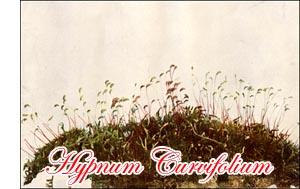Hypnum Curvifolium Moss
 Hypnum curvifolium, Hedw.
Hypnum curvifolium, Hedw.Habit and habitat.-This attractive moss grows in intricate tufts, yellowish-green and glossy. It is very common on decayed logs in shady woods.
Name.-The specific name, is from the Latin curvum, and folium, a leaf.
Plant (gametophyte).-Large, stems, 3 to 4 prostrate with but few branches, these featherbranchlets compressed, unequal, and short.
Leaves.-Crowded, in two rows, each leaf overlapping the one in front, scythe-shaped concave and turned to one side; base, eared; apex gradually long taperpointed; margin slightly serrate; vein absent or slightly evident at the base, cells above pale, narrow, linear and worm-like; cells of the base and angles, shorter, broader, and golden-yellow.
Leaves at the base of the pedicel (perichaetial leaves).-Numerous, whitish, erect; and close, the cells loose.
Habit of flowering.-Male and female flowers on separate plants (dioicous).
Veil (calyptra).-Thin and split up one side.
Spore-case.-Large, oblong, swollen, and arched, when young; thin and distinctly ribbed, when dry.
Pedicel.-Long and slender.
Lid (operculum).-Conical, with a short abrupt point.
Teeth (peristome).-Yellow with small blade-like projections on the inside ; segments of the inner membrane slightly cleft ; cilia 2 to 3, nearly as long as the segments.
Annulus.-With three rows of cells, rolling back as the lid falls.
Spores.-Mature in fall.
Distribution.-North America.
Hypnum Curvifolium picture